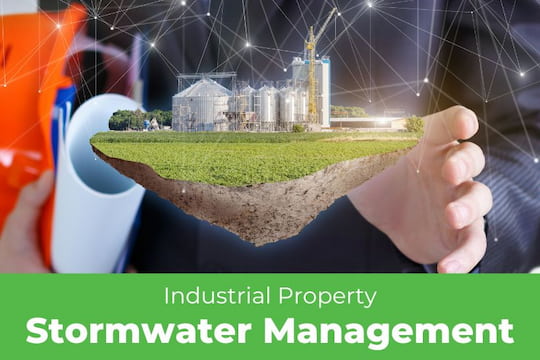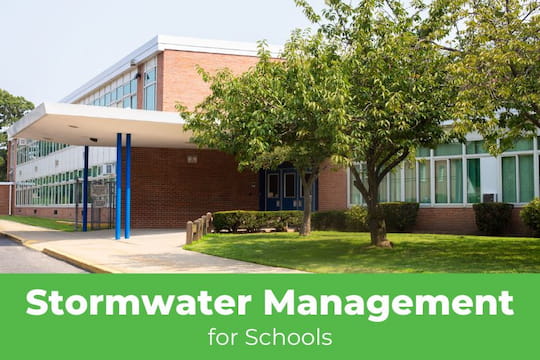Shopping centers have unique challenges that affect how they manage stormwater. With the increase in rainfall due to climate change and other issues, conventional stormwater management for shopping centers often needs help to keep up. However, viable solutions exist to address these unique challenges, and when property managers, owners, and tenants work together, minimizing pollutants and managing stormwater becomes much easier.
Extensive Paved Surfaces

When managing stormwater, one of the challenges shopping malls face is the vast amount of paved, impervious surfaces that produce large volumes of runoff during rainstorms.
Sometimes, a shopping center’s stormwater management system infrastructure is inadequate or poorly designed and cannot manage the runoff volume. Additionally, due to climate change, some areas now experience more rainfall than in the past, meaning shopping centers built years ago struggle to get by with outdated systems.
Enter green infrastructure, which can take the load off stormwater management for shopping centers by providing several ways to keep the stormwater on the property instead of running off. Shopping areas can capture the runoff from roofs, parking lots, and walkways and channel it into depressed, planted areas called rain gardens. These areas typically retain the water for 12–48 hours, which lets the water soak into the ground while filtering out pollutants. The rainwater soaks in fast enough to prevent mosquitos and other issues stemming from standing water. Rain gardens and other green stormwater management features can also enhance the aesthetic beauty of these commercial properties.
High Traffic Areas
Shopping centers usually have a heavy traffic load all day, every day. The increased traffic levels contribute to a higher load of pollutants, such as car oil and hydrocarbons. Shoppers also leave behind garbage and other debris that gets swept up in stormwater runoff. These pollutants end up in local waterways, with minimal filtering or treatment. Shopping centers must also deal with specific regulatory requirements, which may need dedicated staff to accumulate the knowledge needed to keep the system compliant.
Answering this challenge includes implementing an updated stormwater system maintenance plan. A professional stormwater management firm can inspect and assess the system, recommend the type and timing of critical maintenance tasks, and provide expertise on regulatory issues and any benefits, such as available incentives.
Maintenance Challenges from Commercial Activities

Shopping centers host a diverse selection of tenants, which can create stormwater system maintenance challenges due to the variety of potential pollutants from trade-related wastewater and other sources. If not properly handled, the restaurant wastewater, for example, may contain concentrated pollution levels such as oils, grease, and other substances that build up and clog storm drains. Improper waste disposal and the many stakeholders involved increase the complexity of this issue and can make it harder for the shopping center’s stormwater management to succeed.
A key part of shopping center stormwater maintenance includes advanced filtration techniques and the performance of regular maintenance such as storm drain clean out. Catch basins are important in trapping pollutants and debris so they do not continue downstream. However, they also need regular maintenance and clean-outs.
Shopping centers have regulatory requirements that mandate implementing specific control measures at the source of pollutants to minimize them in the center's runoff, which can also prevent buildups and clogs in the storm drains.
Public Access
The stormwater system designed for a shopping mall must have enough capacity and integrate safety and design features to accommodate the property’s needs while keeping the public safe. Certain types of devices used in stormwater management for shopping centers would not be practical in an area with a high foot traffic flow.
To minimize the impacts of heavy public use in shopping centers and the potential of tenants to contribute to issues that impact stormwater systems, educating the stakeholders and promoting a collaborative effort can bring about positive change. Stakeholders include property managers and owners, in addition to tenants.
Preserving Aesthetics

Many shopping centers have landscaped common areas that increase the beauty and appeal of the area to attract more retail traffic. The large amounts of vegetation and landscaping can become detrimental to stormwater systems if not regularly trimmed and maintained. Branches and leaves can easily clog storm drains, leading to floods. Poorly maintained, landscaped areas with scant ground cover can erode due to runoff, depositing significant amounts of sediment into storm drains and filling catch basins. Beauty bark can easily wash into storm drains and is not recommended.
Green infrastructure, such as permeable pavement, green roofs, and rain gardens, can add natural beauty while keeping significant rainwater on the property. As developers become more in tune with best practices for stormwater management, they are increasingly integrating aesthetic considerations when designing the shopping center’s stormwater management system.
Clean Drains Keep Problems at Bay
Due to heavier rainfall and environmental pressures, shopping centers must upgrade and adapt their stormwater management systems and techniques. By partnering with professionals for storm drain cleaning and other maintenance tasks, shopping malls can alleviate the burden of effective stormwater system maintenance. CatchAll Environmental helps shopping centers pave the way toward more sustainable stormwater solutions that benefit businesses and the environment—call us today to see how we can help.













.jpg)

